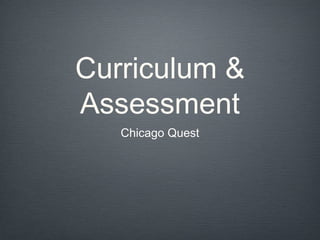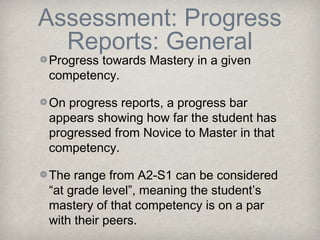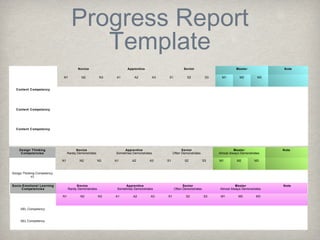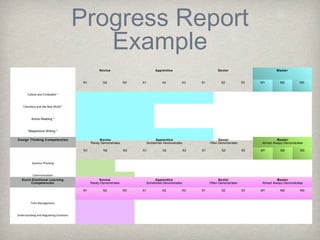Curriculum and Assessment
- 1. Curriculum & Assessment Chicago Quest
- 2. Curriculum: Performance Tasks Every Mission is made up of Quests. Each Quest is evaluated by one or more Performance Tasks. Performance Tasks Rubrics give information about how well a student completed that performance task. Performance Task Rubrics are broken into four main columns; Novice, Apprentice, Senior, and Master. Student progress is marked along the 12 boxes from N1-M3.
- 3. Curriculum: Domains BSP - Being, Space and Place SFTM - Sports for the Mind CW - Code Worlds W or Well - Wellness TWTW - The Way Things Work
- 4. Assessment: Goals To support student growth and progress To communicate to students and parents progress towards mastery of a given competency. To create a record of student progress.
- 5. Performance Task Rubric Novice Apprentice Senior Master Note N1 N2 N3 A1 A2 A3 S1 S2 S3 M1 M2 M3 Content Competency Content Competency Design Thinking Novice Apprentice Senior Master Results Competencies Rarely Demonstrates Sometimes Demonstrates Often Demonstrates Almost Always Demonstrates Content Competency N1 N2 N3 A1 A2 A3 S1 S2 S3 M1 M2 M3 Design Thinking Competency Socio-Emotional Novice Apprentice Senior Master Results Learning Rarely Demonstrates Sometimes Demonstrates Often Demonstrates Almost Always Demonstrates Competencies Design Thinking Competency N1 N2 N3 A1 A2 A3 S1 S2 S3 M1 M2 M3 SEL Competency
- 6. Assessment: Progress Reports: General Progress towards Mastery in a given competency. On progress reports, a progress bar appears showing how far the student has progressed from Novice to Master in that competency. The range from A2-S1 can be considered ŌĆ£at grade levelŌĆØ, meaning the studentŌĆÖs mastery of that competency is on a par with their peers.
- 7. Progress Report Template Novice Apprentice Senior Master Note N1 N2 N3 A1 A2 A3 S1 S2 S3 M1 M2 M3 Content Competency Content Competency Content Competency Design Thinking Novice Apprentice Senior Master Note Competencies Rarely Demonstrates Sometimes Demonstrates Often Demonstrates Almost Always Demonstrates N1 N2 N3 A1 A2 A3 S1 S2 S3 M1 M2 M3 Design Thinking Competency #1 Design Thinking Competency Socio-Emotional Learning Novice Apprentice Senior Master Note #2 Competencies Rarely Demonstrates Sometimes Demonstrates Often Demonstrates Almost Always Demonstrates N1 N2 N3 A1 A2 A3 S1 S2 S3 M1 M2 M3 SEL Competency SEL Competency
- 8. Assessment: Progress Reports: Competencies The progress report shows progress in three areas: Content, Design Thinking, and Socio-Emotional Competencies. Content Competency categories are developed by the teachers in coordination with the Curriculum Specialists to describe particular combinations or sets of standards and enduring understandings.
- 9. Assessment: Progress Report: Competencies, Design Thinking pt Socio-Emotional and 2 competencies represent specific skills and habits. Design Thinking competencies include such areas as: Ideation, Listening, Critique, Designing Symbols and Tools, etc. Socio-Emotional Learning competencies include: Understanding and Regulating Emotions, Teamwork, and Time Management
- 10. Progress Report Example Novice Apprentice Senior Master N1 N2 N3 A1 A2 A3 S1 S2 S3 M1 M2 M3 Culture and Civilization * Columbus and the New World * Active Reading * Responsive Writing * Design Thinking Competencies Novice Apprentice Senior Master Rarely Demonstrates Sometimes Demonstrates Often Demonstrates Almost Always Demonstrates N1 N2 N3 A1 A2 A3 S1 S2 S3 M1 M2 M3 Systems Thinking Communication Socio-Emotional Learning Novice Apprentice Senior Master Competencies Rarely Demonstrates Sometimes Demonstrates Often Demonstrates Almost Always Demonstrates N1 N2 N3 A1 A2 A3 S1 S2 S3 M1 M2 M3 Time Management Understanding and Regulating Emotions
- 11. Progress Report Example, Page 2 Culture and Civilization Enduring Understanding: The components of a flourishing civilization include the elements of survival as well as government, division of labor, technology, and economics. Enduring Understanding: The components of survival are the inherent components of civilization: food, water, energy, shelter. 17.C.3a Explain how human activity is affected by geographic factors. 17.C.3b Explain how patterns of resources are used throughout the world. 17.C.3c Analyze how human processes influence settlement patterns including migration and population growth. 18.A.3 Explain how language, literature, the arts, architecture and traditions contribute to the development and transmission of culture. 18.B.3b Explain how social institutions contribute to the development and transmission of culture. Columbus and the New World 16.B.3d (W) Describe political effects of European exploration and expansion on the Americas, Asia, and Africa after 1500 CE. 16.C.3a (US) Describe economic motivations that attracted Europeans and others to the Americas, 1500-1750. 16.C.3b (W) Describe the economic systems and trade patterns of North America, South America and Mesoamerica before the encounter with the Europeans. 16.C.3c (W) Describe the impact of technology (e.g., weaponry, transportation, printing press, microchips) in different parts of the world, 1500 - present. Responsive Writing CC.7.W.1 Text Types and Purposes: Write arguments to support claims with clear reasons and relevant evidence. CC.7.W.2 Text Types and Purposes: Write informative/explanatory texts to examine a topic and convey ideas, concepts, and information through the selection, organization, and analysis of relevant content. CC.7.W.3 Text Types and Purposes: Write narratives to develop real or imagined experiences or events using effective technique, relevant descriptive details, and well-structured event sequences. CC.7.W.7 Research to Build and Present Knowledge: Conduct short research projects to answer a question, drawing on several sources and generating additional related, focused questions for further research and investigation. CC.7.W.10 Range of Writing: Write routinely over extended time frames (time for research, reflection, and revision) and shorter time frames (a single sitting or a day or two) for a range of discipline-specific tasks, purposes, and audiences. CC.7.SL.1 Comprehension and Collaboration: Engage effectively in a range of collaborative discussions (one-on-one, in groups, and teacher-led) with diverse partners on grade 7 topics, texts, and issues, building on othersŌĆÖ ideas and expressing their own clearly. CC.7.L.1 Conventions of Standard English: Demonstrate command of the conventions of standard English grammar and usage when writing or speaking. CC.7.L.2.b Conventions of Standard English: Spell correctly. CC.7.L.4.c Vocabulary Acquisition and Use: Consult general and specialized reference materials (e.g., dictionaries, glossaries, thesauruses), both print and digital, to find the pronunciation of a word or determine or clarify its precise meaning or its part of speech. Active Reading CC.7.R.L.3 Key Ideas and Details: Analyze how particular elements of a story or drama interact (e.g., how setting shapes the characters or plot). CC.7.R.L.10 Range of Reading and Level of Text Complexity: By the end of the year, read and comprehend literature, including stories, dramas, and poems, in the grades 6ŌĆō8 text complexity band proficiently, with scaffolding as needed at the high end of the range.
- 12. Assessment: Objectives Our objective is to provide accurate information about student progress within the competencies listed. Competency Confusion - Turning something in late is not the same as doing it poorly.
- 13. Assessment: Homework Homework is an additional space for students to engage in their Quests and Missions. Homework is viewed as an enrichment to the classroom space. We believe homework is most valuable in three ways: An opportunity to review and revisit the dayŌĆÖs work. An opportunity to engage in reading or other individualistic tasks that can support the classroom. An opportunity for larger projects and papers that are individually focused.













